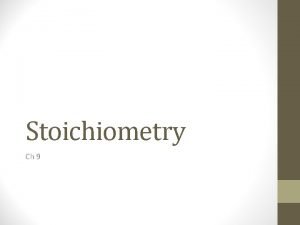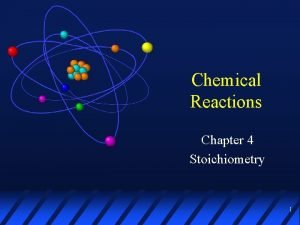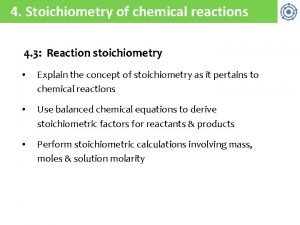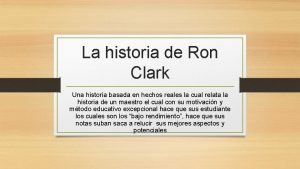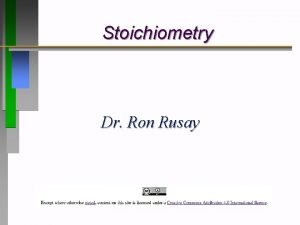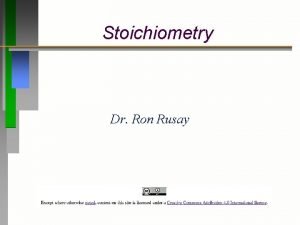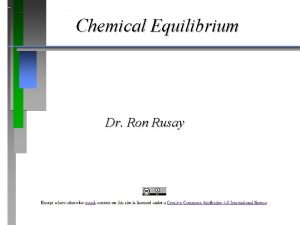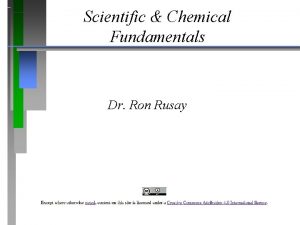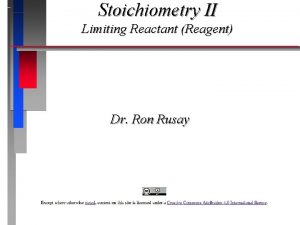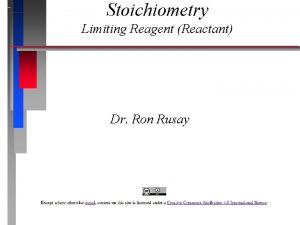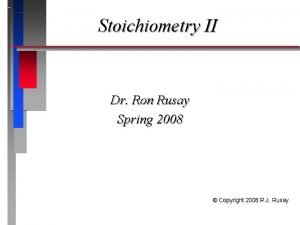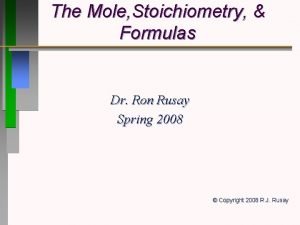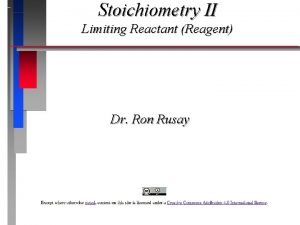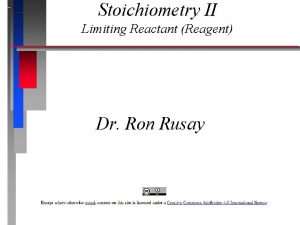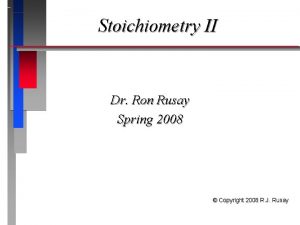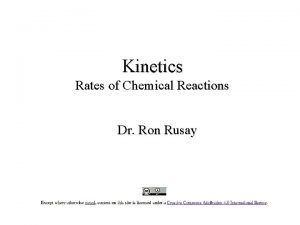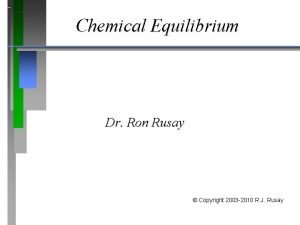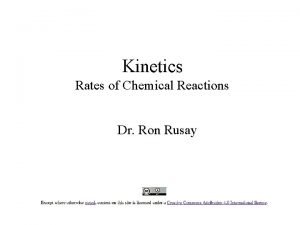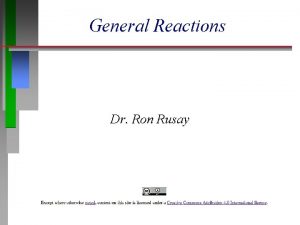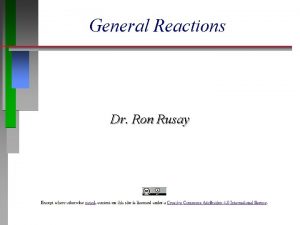Stoichiometry Dr Ron Rusay Chemical Stoichiometry Stoichiometry is





















- Slides: 21

Stoichiometry Dr. Ron Rusay

Chemical Stoichiometry ð Stoichiometry is the study of mass in chemical reactions. It deals with both reactants and products. ð It quantitatively and empirically relates the behavior of atoms and molecules in a balanced chemical equation to observable chemical change and measurable mass effects. ð It accounts for mass and the conservation of mass, just as the conservation of atoms in a balanced chemical equation.

Chemical Reactions Atoms, Mass & Balance: eg. Zn(s) + S(s)

Stoichiometry Must begin with a correctly balanced equation: _ C 2 H 5 OH + _ O 2 _ CO 2 + _ H 2 O Reactants Products • C=2; H =5+1=6; O=2+1 • C=1; H=2; O=2+1 1 C 2 H 5 OH + 3 O 2 2 CO 2 + 3 H 2 O

https: //phet. colorado. edu/sims/html/balancing-chemicalequations/latest/balancing-chemical-equations_en. html

Chemical Equation C 2 H 5 OH + 3 O 2 2 CO 2 + 3 H 2 O The balanced equation can be completely stated as: ð 1 mole of ethanol reacts with 3 moles of oxygen to produce 2 moles of carbon dioxide and 3 moles of water.

Chemical Equation All Balanced Equations relate on a molar mass basis. For example the combustion of octane: 2 C 8 H 18(l)+ 25 O 2(g) 16 CO 2(g) +18 H 2 O(l) 2 moles of octane react with 25 moles of oxygen to produce 16 moles of carbon dioxide and 18 moles of water.

The Chemical Equation: Mole & Masses C 2 H 5 OH + 3 O 2 2 CO 2 + 3 H 2 O ð 46 g (1 mole) of ethanol reacts with 3 moles of oxygen (96 g) to produce 2 moles of carbon dioxide and 3 moles of water. ð How many grams of carbon dioxide and water are respectively produced from 46 g (1 mole) of ethanol ? 2 mol x 44 g/mol = 88 g 3 mol x 18 g/mol = 54 g

The Chemical Equation: Moles & Masses • C 2 H 5 OH + 3 O 2 2 CO 2 + 3 H 2 O ð How many grams of oxygen are needed to react with 15. 3 g of ethanol in a 12 oz. beer ? 15. 3 gethanol x molethanol /46. 0 gethanol = 0. 333 molethanol x 3 moloxygen / 1 molethanol = 0. 999 moloxygen 32. 0 goxygen /moloxygen x 0. 999 moloxygen = 32. 0 goxygen NOTE: It takes approximately 1 hour for the biologically equivalent amount of oxygen available from cytochrome p 450 to consume the alcohol in a human in 1 beer to a level below the legal limit of 0. 08%.

Chemical Stoichiometry ð ð Epsom salt (magnesium sulfate heptahydrate) is one of five possible hydrates: mono-, di-, tri-, hexa-, or hepta- hydrate. How can stoichiometry be used to determine, which hydrate is present in a pure unknown sample, by heating the sample in a kitchen oven at 400 o C for 45 minutes? Mg. SO 4. x H 2 O(s) Mg. SO 4 (s) + x H 2 O (g) Refer to % Hydrate Lab Experiment.

Mass Calculations All Balanced Equations relate on a molar and mass basis. For the combustion of octane: 2 C 8 H 18(l)+ 25 O 2(g) 16 CO 2(g) +18 H 2 O(l) 228 g of octane (2 moles)* will react with 800 g of oxygen (25 moles) to produce (16 moles) 704 g of carbon dioxide and (18 moles) 324 g of water. *(2 moles octane x 114 g/mol = 228 g )

Mass Calculations: Reactants Products

Mass Calculations: Reactants Products 1. 2. 3. 4. 5. Balance the chemical equation. Convert mass of reactant or product to moles. Identify mole ratios in balanced equation: They serve as the “Gatekeeper”. Calculate moles of desired product or reactant. Convert moles to grams.

Mass Calculations: Reactants Products

QUESTION The fuel in small portable lighters is butane (C 4 H 10). After using a lighter for a few minutes, 1. 0 gram of fuel was used. How many moles of carbon dioxide would it produce? A. B. C. D. 58 moles 0. 017 moles 1. 7 10– 24 moles 0. 068 moles

Mass Calculations: Reactants Products

QUESTION The fuel in small portable lighters is butane (C 4 H 10). After using a lighter for a few minutes, 1. 0 gram (0. 017 moles) of fuel was used. How many grams of carbon dioxide would it produce? How many grams of carbon dioxide would this produce? A. ) 750 mg B. ) 6. 0 g C) 1. 5 g D. ) 3. 0 g

Percent Yield �In synthesis as in any experimentation, it is very difficult and at most times impossible to be perfect. Therefore the actual yield (g) is measured and compared to theoretical calculated yield (g). This is the percent yield: �% Yield = actual (g) / theoretical (g) x 100 Some DVC students may report percent yields greater than 100% in their first synthesis experiment. Hmmm? . . . . Why is this not possible?

Theoretical (Yield) Mass Calculations Reactant Product grams (Reactant) grams (Product) Moles Molar Mass grams (R) 1 mol (R) grams (R) (Divide) by Molar Mass (R) ? mol (P) ? mol (R) grams (P) ? grams (P) 1 mol (P) (Multiply) "Gatekeepers” from Balanced reaction by Molar Mass (P)

Theoretical (Yield) Mass Calculation 1 C 20 H 24 N 2 O(s) + H 2 (g) 1 C 20 H 26 N 2 O(s) Ibogaine 3. 03 grams (C 20 H 24 N 2 O. Reactant) 308. 4 g·mol− 1 grams (C 20 H 26 N 2 O Product) Moles Molar Mass Ibogaine 310. 4 g·mol− 1 310. 4 3. 03 grams (R C 20 H 24 N 2 O) ? 1 mol (R) 308. 4 Grams (R C 20 H 24 N 2 O) ? 1 mol (P) ? 1 mol (R) "Gatekeepers” from by Molar Balanced reaction Mass (R C 20 H 24 N 2 O) (Divide) 3. 05 grams (P C 20 H 26 N 2 O) ? 1 mol (P) (Multiply) by Molar Mass (P C 20 H 26 N 2 O) grams (P)

QUESTION � A synthetic hydrogenation reaction produced 2. 85 g of Ibogaine, C 20 H 26 N 2 O, a natural product with strong promise in treating heroin addiction (at least in Europe), the calculated theoretical yield was 3. 05 g, what is the % yield? A) 6. 6% B) 80. 3% C) 93. 4% D) 107%
 Rusay
Rusay Chemical rxns/balancing equ./stoichiometry
Chemical rxns/balancing equ./stoichiometry Chemical accounting: stoichiometry
Chemical accounting: stoichiometry Stoichiometry refers to
Stoichiometry refers to Chemical accounting: stoichiometry
Chemical accounting: stoichiometry Types of chemical reactions and solution stoichiometry
Types of chemical reactions and solution stoichiometry Stoichiometry map for chemical reactions
Stoichiometry map for chemical reactions Types of chemical reactions and solution stoichiometry
Types of chemical reactions and solution stoichiometry Section 2 classifying chemical reactions
Section 2 classifying chemical reactions Chemical formulas and chemical compounds chapter 7 review
Chemical formulas and chemical compounds chapter 7 review Chapter 7 chemical formulas and chemical compounds test
Chapter 7 chemical formulas and chemical compounds test Chapter 18 chemical reactions balancing chemical equations
Chapter 18 chemical reactions balancing chemical equations Chemical reactions section 2 classifying chemical reactions
Chemical reactions section 2 classifying chemical reactions Chemical reactions section 1 chemical changes
Chemical reactions section 1 chemical changes Biografia de ron clark
Biografia de ron clark Ron mak sjsu
Ron mak sjsu How were conglomerates and franchises alike and different
How were conglomerates and franchises alike and different Ron berger feedback
Ron berger feedback Ron berger
Ron berger Ron clarke 1992
Ron clarke 1992 Andrea hardcastle ron williamson
Andrea hardcastle ron williamson Ron mc slide
Ron mc slide


